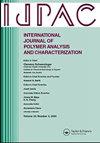Effect of dimethylamine pyrophosphate on the mechanical, thermal decomposition and flame-retardant properties of rigid polyurethane foams
IF 1.6
4区 工程技术
Q4 POLYMER SCIENCE
International Journal of Polymer Analysis and Characterization
Pub Date : 2025-04-03
DOI:10.1080/1023666X.2024.2446597
引用次数: 0
Abstract
To solve the problem of the insufficient flame retardancy of rigid polyurethane (RPUF), a new flame retardant, dimethylamine pyrophosphate (DMPY), was introduced into rigid polyurethane foam, and one-step foaming technology was used to prepare RPUF/DMPY composites. Furthermore, the thermal stability, flame retardancy, combustion characteristics, and gas-phase products were analyzed via thermogravimetric analysis (TGA), limiting oxygen index (LOI), cone calorimetry (CCT), and thermogravimetric infrared spectroscopy (TG-FTIR). The flame-retardant measurements revealed that when the DMPY amount exceeded 20 parts, the LOI of the RPUF/DMPY composites increased to above 23%, and all the samples reached the UL-94 V-0 level. In addition, the peak heat release rate and total heat release values of the RPUF-3 composites prepared with RPUF/DMPY were 192.6 kW/m2 and 19.98 MJ/m2, respectively, which were 35.0% and 29.1% lower than those of the pure RPUF, respectively, and significantly reduced the heat release of the RPUF composites. The analysis of char residue revealed that DMPY can effectively improve the density and graphitization degree of char residue during the combustion process of RPUF/DMPY composites, thereby endowing them with excellent flame-retardant properties. On this basis, the flame-retardant mechanism of the DMPY-based flame retardant RPUF composite material is proposed. This work provides new ideas for the development of new flame retardant PPUF composites.
焦磷酸二甲胺对硬质聚氨酯泡沫塑料力学、热分解及阻燃性能的影响
为解决硬质聚氨酯(RPUF)阻燃性不足的问题,将新型阻燃剂焦磷酸二甲胺(DMPY)引入硬质聚氨酯泡沫中,采用一步发泡技术制备了RPUF/DMPY复合材料。通过热重分析(TGA)、极限氧指数(LOI)、锥量热法(CCT)、热重红外光谱(TG-FTIR)等方法对其热稳定性、阻燃性、燃烧特性和气相产物进行了分析。阻燃测试结果表明,当DMPY添加量超过20份时,RPUF/DMPY复合材料的LOI值提高到23%以上,样品均达到UL-94 V-0水平。此外,用RPUF/DMPY制备的RPUF-3复合材料的峰值放热率和总放热值分别为192.6 kW/m2和19.98 MJ/m2,分别比纯RPUF低35.0%和29.1%,显著降低了RPUF复合材料的放热率。炭渣分析表明,DMPY可以有效提高RPUF/DMPY复合材料燃烧过程中炭渣的密度和石墨化程度,从而使其具有优异的阻燃性能。在此基础上,提出了dmp基阻燃RPUF复合材料的阻燃机理。本研究为新型阻燃聚puf复合材料的开发提供了新的思路。
本文章由计算机程序翻译,如有差异,请以英文原文为准。
求助全文
约1分钟内获得全文
求助全文
来源期刊
CiteScore
3.50
自引率
5.30%
发文量
37
审稿时长
1.6 months
期刊介绍:
The scope of the journal is to publish original contributions and reviews on studies, methodologies, instrumentation, and applications involving the analysis and characterization of polymers and polymeric-based materials, including synthetic polymers, blends, composites, fibers, coatings, supramolecular structures, polysaccharides, and biopolymers. The Journal will accept papers and review articles on the following topics and research areas involving fundamental and applied studies of polymer analysis and characterization:
Characterization and analysis of new and existing polymers and polymeric-based materials.
Design and evaluation of analytical instrumentation and physical testing equipment.
Determination of molecular weight, size, conformation, branching, cross-linking, chemical structure, and sequence distribution.
Using separation, spectroscopic, and scattering techniques.
Surface characterization of polymeric materials.
Measurement of solution and bulk properties and behavior of polymers.
Studies involving structure-property-processing relationships, and polymer aging.
Analysis of oligomeric materials.
Analysis of polymer additives and decomposition products.

 求助内容:
求助内容: 应助结果提醒方式:
应助结果提醒方式:


